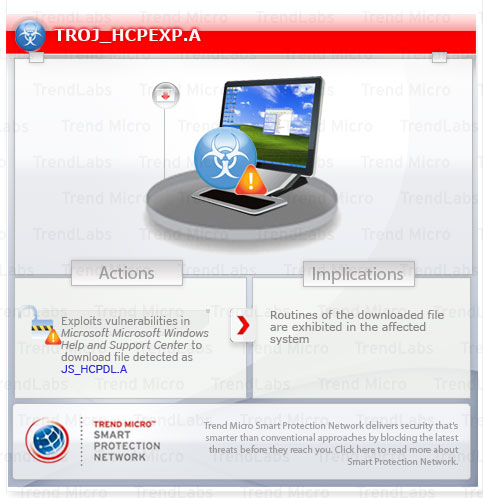TROJ_HCPEXP.A
Windows 98, ME, NT, 2000, XP, Server 2003


Threat Type: Trojan
Destructiveness: No
Encrypted: No
In the wild: Yes
OVERVIEW
Trend Micro has flagged this Trojan as noteworthy due to the increased potential for damage, propagation, or both, that it possesses.
To get a one-glance comprehensive view of the behavior of this Trojan, refer to the Threat Diagram shown below.

This Trojan may be hosted on a website and run when a user accesses the said website.
It executes downloaded files whose malicious routines are exhibited by the affected system.
TECHNICAL DETAILS
Varies
Script
No
15 Jun 2010
Connects to URLs/IPs, Downloads files
Arrival Details
This Trojan may be hosted on a website and run when a user accesses the said website.
Dropping Routine
This Trojan takes advantage of the following software vulnerabilities to drop malicious files:
- Microsoft Microsoft Windows Help and Support Center
Download Routine
After successfully exploiting the said vulnerability, this malware connects to the following URLs to possibly download other malicious files:
- http://php.{BLOCKED}urcecms.com/include/23.php
It saves the files it downloads using the following names:
- %User Temp%\1.js - detected as JS_HCPDL.A
(Note: %User Temp% is the current user's Temp folder, which is usually C:\Documents and Settings\{user name}\Local Settings\Temp on Windows 2000, XP, and Server 2003.)
It executes downloaded files :
Other Details
This Trojan connects to the following possibly malicious URL:
- hcp://{BLOCKED}es/search?query=anything&topic=hcp://system/sysinfo/sysinfomain.htm
- hcp://{BLOCKED}es/search?query=a&topic=hcp://system/sysinfo/sysinfomain.htm
More information on this vulnerability can be found below:
SOLUTION
8.900
7.244.18
15 Jun 2010
7.245.00
16 Jun 2010
Step 1
For Windows XP and Windows Server 2003 users, before doing any scans, please make sure you disable System Restore to allow full scanning of your computer.
Step 3
Close all opened browser windows
Step 4
Scan your computer with your Trend Micro product to delete files detected as TROJ_HCPEXP.A. If the detected files have already been cleaned, deleted, or quarantined by your Trend Micro product, no further step is required. You may opt to simply delete the quarantined files. Please check this Knowledge Base page for more information.
Did this description help? Tell us how we did.

